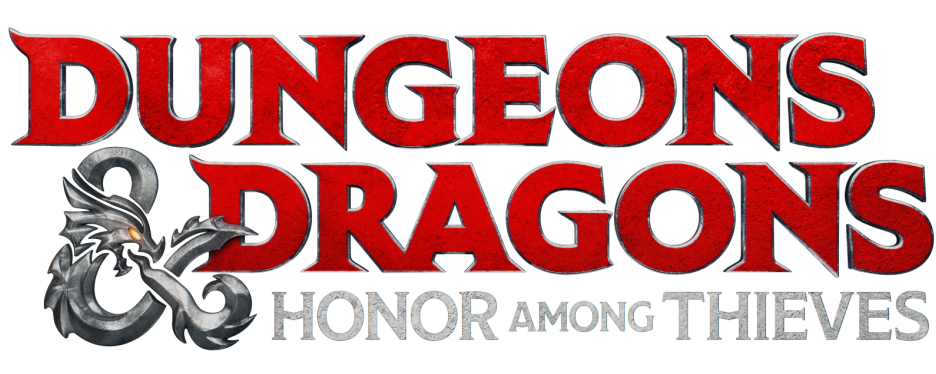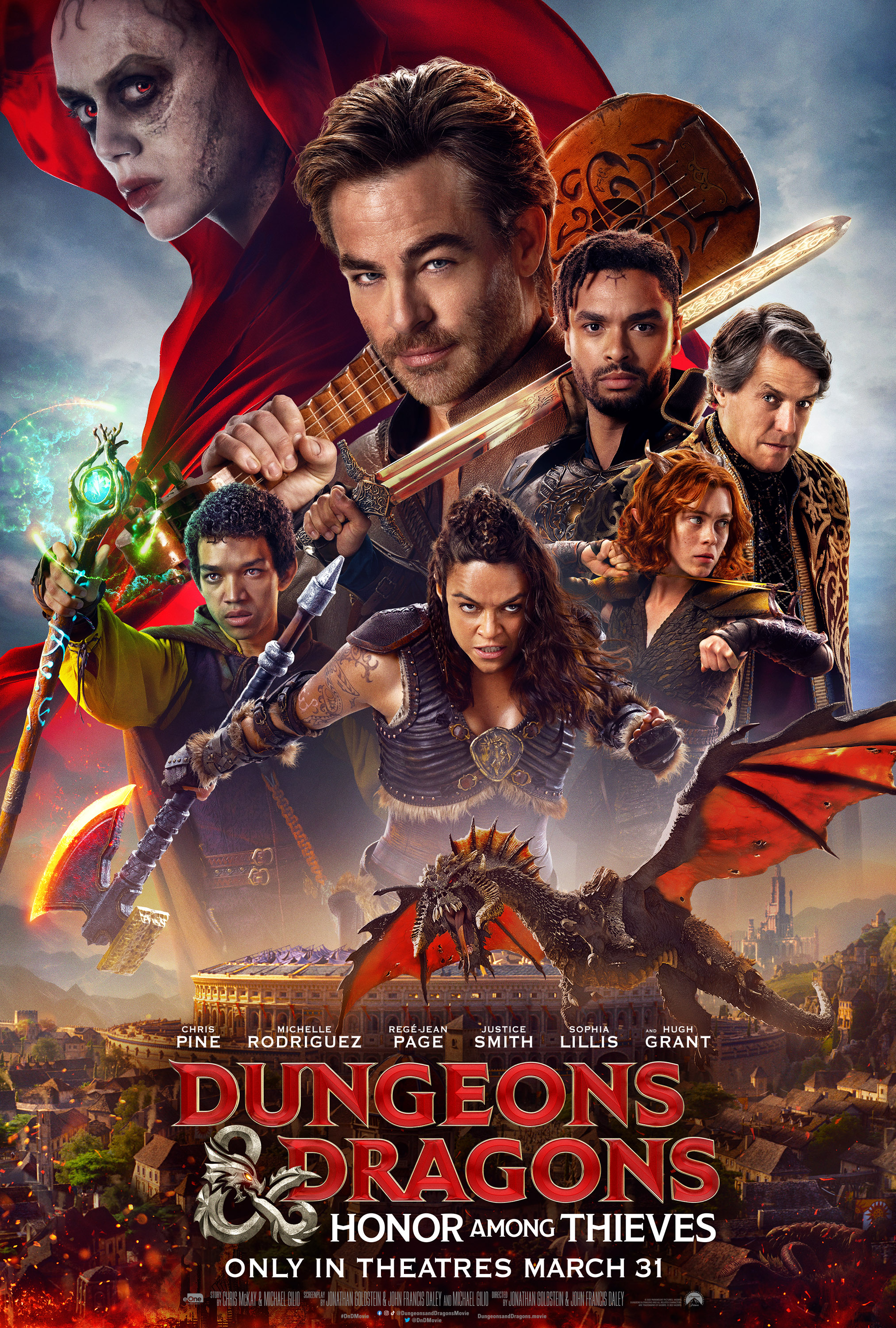
One is always tempted to write something like, “This is the perfect D&D movie.”
But such a statement almost immediately raises the question: What would the perfect D&D movie look like? Would it be a Temple of Elemental Evil dungeon crawler? The gothic horror of Castle Ravenloft? The epic fantasy of the Dragonlance Saga? An isekai like the animated series? A remake of Cube in the Tomb of Horrors?
So let us instead say that this is A perfect D&D movie.
Normally when I review films, I try to avoid discussing anything in detail after the first fifteen minutes without a spoiler warning. But Honor Among Thieves challenges that policy because the first fifteen minutes is so packed with action, character development, and insanely clever narrative layering that it feels a bit unfair to you to lay it bare. (If you’re not completely onboard with the film by the end of the first fifteen minutes, then you’re probably going to be in for a rough ride.) So I’m just going to mention a few key points and then we’ll head into spoiler territory:
- This movie feels like playing in a truly great D&D campaign in the best possible way.
- Daley & Goldstein, along with co-writer Michael Gilio, have crammed a truly insane amount of D&D lore into this film, and not once does it feel forced or self-indulgent.
- It’s simply a joyful experience, but also one that has a legitimate emotional core. I legitimately teared up at the end, because the film had been so successful at getting me invested in its characters.
If you are any sort of D&D fan — or even if you just enjoy fun fantasy films — then you owe it to yourself to go see this movie.
SPOILER WARNING!
Honestly, I think the scene that best captures what this film is about is the speak with dead sequence: The heroes need to learn what happened on a battlefield a few hundred years ago, and so they start digging up corpses.
The scene starts with Holga, the barbarian played by Michelle Rodriguez, talking about how she always dreamed she would be buried in holy ground like this. The emotional beat lands, in large part because it flows directly out of the previous scene, and also serves to pivot us into the first speak with dead:
Simon: I read this incantation. Once the dead man is revived, we can ask him five questions, at which point he will die again, never to return.
(…)
Edgin: Here we go. Were you killed in the Battle of the Evermoors?
Corpse: Yes.
Edgin: Four more questions, right?
Corpse: Yes.
Edgin: No, that one wasn’t for you. Did that count?
Corpse: Yes.
Edgin: Dammit. Only answer when I talk to you, OK?
Corpse: Yes.
Simon: Why would you say “okay” at the end of that sentence?
Corpse: I didn’t.
(The corpse dies.)
This isn’t the best scene in the movie. (It would be hard to pick one. There are so many great scenes in this film.) But it showecases everything the film does well:
It is constantly developing characters, which is what allows it to have four fully developed character arcs plus another three or four vividly realized members of the supporting cast.
It achieves that wild blend of irreverent comedy, monstrous horror, and heartfelt epic that characterize many of the finest D&D campaigns.
It does a simply brilliant job of capturing iconic moments from the game table and putting them onscreen in a way that honors and celebrates them, while also making them completely accessible and fun and thrilling even if you’ve never played a session of D&D in your entire life.
“But she turns into an owlbear, Justin! I’ve seen the trailer! That’s clearly not allowed by the rules!”
Okay, first: Get the fuck out. You don’t deserve nice things.
And second: Yeah, that’s fucking right. The movie even has house rules. How could it be an authentic representation of D&D if it didn’t?
It even manages to somehow feature an honest-to-gods GMPC (played by Regé-Jean Page) for a dozen or so scenes.
My one and only real critique of the film is that I would’ve liked it to have been daring enough (or, at least, empowered enough) to actually shake up the status quo in the Forgotten Realms. Instead, everything needs to be more or less tucked back where it belongs at the end of the film. (On the other hand, I guess I’m also glad D&D’s lore is still being driven by the RPG and not by the feature film.)
In any case, I’ll be heading back to the theater to see it again next week, which will make it the first film I’ve seen twice in theaters since the pandemic started. I don’t think I can really give it a better recommendation than that.
GRADE: B+













It will be some time before I can get to a theater showing this, so I only have one question.
Does the movie feature any (for lack of a better term) diegetic intrusions from the “real world/living room table”, sort of like the framing device of The Princess Bride?
Cuz to me that would help make A perfect D&D movie vs a Forgotten Realms movie.
You don’t need to post this, but I think you’re thought got cut off:
“four fully developed character arcs plus another three or four vividly”
I’d love to see you expound on why you gave it such a glowingly detailed review, and then a frigging B+ ?!
Please give us a better indication of why it was 3 levels below maximum, when your only apparent (per blog post) gripe was that it didn’t affect the external source material permanently…
I recommend checking out the grading guide.
Is this movie really good? Will D&D fans, specifically, likely love it and want to watch it multiple times? Absolutely.
Is it one of the greatest films of all time? No.
Will the general audience likely enjoy it, but probably not be compelled to multiple viewings? Yes.
B+. The movie is very enjoyable, I recommend it, and it might be worth rewatching. The + represents some truly great moments and also the fact that I think this is a film most D&D fans will end up watching many times.
I liked the running gag of Ed not wanting to carry stuff and giving it to Simon.
That was a really good nod to something many players do at the table.
The movie was amazing, far surpassed my expectations!
The only thing I didn’t enjoy about it was that (at least at the special pre-release AMC showing I went to) there was like a 10 minute “sneak preview” segment BEFORE THE MOVIE STARTED featuring not only footage from the movie, but also the cast talking about their favorite scenes and their characters’ motivations.
This is a horrifying trend I’ve started to see in theaters – advertising the movie I am ABOUT TO WATCH and ALREADY PAID FOR. I would have loved to know the cast’s thoughts and how many practical effects there were AFTER watching the movie.
Since you (Justin) posted this before the film was out, I assumed you went to a similar thing. I’m curious if you had the same experience being baffled by this.
I guess it was a good movie if my only complaint was something outside the film itself.
It was such a fun movie. It felt like it was the right balance of silly and earnest for me and I really appreciated the framing story.
Nothing I disagreed with in this review!
Have to say the “illegal owlbear” comments make me laugh, because of a) what you say above but really b) it’s not even a house rule! 5e’s stat blocks make it abundantly clear that NPCs are NOT beholden to the player class loadout, even if their stat block evokes said class. The characters of this movie aren’t PCs — obviously, because no one is playing them at a game table, but also because they have published NPC statblocks, which should really drive the point home. So the “sticklers” calling out the owlbear wildshape are, awkwardly, the ones getting the rules wrong. 😀
It did a small shakeup with the Themberchaud scene. In Out of the Abyss he is trapped in Gracklstugh, but the movie put him in Dolblunde.
So, what’s up with the forges in Gracklstugh, do they have a new wyrmsmith? And what happened to Dourgothoth? And how/why did Themberchaud travel so far?
Yes, could have done more, but still interesting questions. Do let me know if I missed the answers and they were in the film.